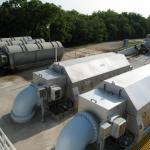Rotoshear® Internally Fed Rotary Screen


The Rotoshear® is a proven high-capacity fine screening technology for wastewater treatment plants and many industries for various applications, spanning 1,000 applications
When installed in wastewater treatment plants, the Rotoshear® unit is renowned as an internally fed rotary screen for pretreatment and primary treatment, often used to replace primary clarifiers, while also being used as sludge screens. Industrial users include a wide variety of industries including, meat processors, food processors, tanneries, textile mills, petrochemical plants, and recyclers, who rely on the technology for product recovery and wastewater treatment. Also, pulp and paper mills use it for fiber recovery and rejects handling.
Our internally fed rotary screen operates with minimal attendance. Influent enters through the inlet and flows into a headbox, which fills and the influent cascades over the weirs and contacts two sides of the rotating cylinder screen. As the influent hits the turning screen, the solids are caught inside the cylinder and the liquid passes through the screen into the process or on for further treatment. Diverters on the cylinder move the solids along the length of the screen to discharge. The unit is equipped with spray bar(s) to easily clean the screen.
The Rotoshear has undergone continuous product development updates to incorporate new design enhancements, and currently it encompasses a complete family of screens, with 12 models with custom features specific to various applications. Opening sizes range from 0.010" to 0.100" (.25 to 2.5 mm) and hydraulic capacities from 450 to over 13,000 GPM (102 to 2955 m3 /h). The material standard is 304 stainless steel, but 316 and L grades are available, as well. Heavy-duty models are available for heavy solids loadings.
Features:
- First of its kind – completely lubrication-free screen.
- Upgraded drive system with long-lasting plastic components.
- Economical option for fine screening.
- Robust proven design with 1,000s of installations.
- Many installations over 20 years old and still in operation.
- No seals to fail – minimal bypass possibility.
- Application-specific customizable options.
- Up to 20 MGD capacity per screen.
Benefits
- Reduces down-time and maintenance costs.
- Easy access to all maintenance items.
- Higher capture rate compared to conventional moving media screens.
- Upgraded drive system eliminates gear teeth engagement problems associated with direct drive systems.
- Upgraded drive system eliminates screen cylinder slippage problems caused by belt drive systems.
- Designed for pumped flow applications – no need to build channels if not needed.
